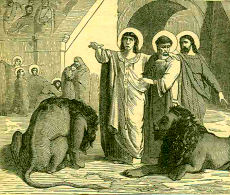
19 September
Optional Memorial
St. Januarius (275-305)
Bishop & Martyr
Born: 275, Benevento or Naples, Campania, Roman Empire
Died: 305, Pozzuoli, Campania
Major Shrine: Cathedral of San Gennaro, Naples, Italy
Patron of: blood banks; Naples; volcanic eruptions
Little is known about St. Januarius. He was Bishop of Benevento in Campania. He died near Naples, about the year 305, martyred under the persecution of Emperor Diocletian. Around the year 400 the relics of St. Januarius were moved to Naples, which honors Januarius as a patron saint. He supposedly protected Naples from a threatened eruption of the volcano Mt. Vesuvius. The “miracle of Januarius” has world-wide fame. At least three times a year—on his feast day, December 16 and the first Sunday of May—the sealed vial with congealed blood of the saint liquifies, froths and bubbles up. This miraculous event has occurred every year, with rare exceptions. Popular tradition holds that the liquefaction is a sign that the year will be preserved from disasters. (In 1939, the beginning of World War II, the blood did not bubble up.)
COLLECT PRAYER
O God, who grant us to venerate the memory of the Martyr Saint Januarius, give us, we pray, the joy of his company in blessed happiness for all eternity. Through our Lord Jesus Christ, your Son, who lives and reigns with you in the unity of the Holy Spirit, God, for ever and ever.
St. Januarius
 Together with his deacons Socius and Festus, and his lector Desiderius, Januarius, bishop of Beneventum, was subjected to most atrocious torturing during the Diocletian persecution (about 304). Nevertheless, with God’s aid they were preserved unmaimed. The wild animals let loose upon them would not attack. Beheaded at Puteoli, their bodies were reverently interred in the neighboring cities. Eventually the remains of St. Januarius became the prized possession of the city of Naples.
Together with his deacons Socius and Festus, and his lector Desiderius, Januarius, bishop of Beneventum, was subjected to most atrocious torturing during the Diocletian persecution (about 304). Nevertheless, with God’s aid they were preserved unmaimed. The wild animals let loose upon them would not attack. Beheaded at Puteoli, their bodies were reverently interred in the neighboring cities. Eventually the remains of St. Januarius became the prized possession of the city of Naples.
“Even to the present time the blood of the saint that is preserved in a glass vial will become fluid shortly after it is brought close to the head of the saint; then it bubbles up in a remarkable manner, as if it had just been shed” (Breviary). Cardinal Schuster makes this statement in his Liber Sacramentorum (vol. 8, p. 233): “The author has seen the marvel of the blood liquefaction at closest range and can give witness to the fact. Taking into consideration all the scientific investigations that have been made, he would say that a natural explanation of the phenomena does not seem possible.”
Excerpted from The Church’s Year of Grace, Pius Parsch
Source: Catholic Culture